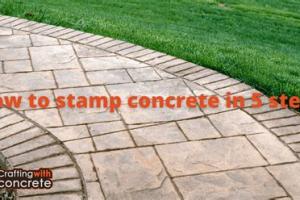A Beginner's Complete Guide to Stamping Concrete: Techniques, Tips & Tools

-
Quick Links:
- 1. Introduction to Stamping Concrete
- 2. Benefits of Stamping Concrete
- 3. Essential Tools for Stamping Concrete
- 4. Stamping Techniques for Beginners
- 5. Preparing the Surface for Stamping
- 6. Step-by-Step Application Guide
- 7. Maintaining Stamped Concrete
- 8. Cost of Stamping Concrete
- 9. Case Studies & Examples
- 10. Expert Insights on Stamping Concrete
- 11. FAQs
1. Introduction to Stamping Concrete
Stamping concrete is a popular technique used to create decorative surfaces that mimic the appearance of natural stones, bricks, and even wood. It has gained immense popularity due to its versatility and affordability compared to traditional materials. This guide will take you through everything a beginner needs to know about stamping concrete, from the tools required to the techniques for achieving stunning results.
2. Benefits of Stamping Concrete
Before diving into the details, let's look at some of the key benefits of stamping concrete:
- Aesthetic Appeal: Stamped concrete can enhance the visual appeal of any outdoor or indoor space.
- Durability: Concrete is known for its strength and longevity, making it a great choice for high-traffic areas.
- Low Maintenance: Stamped concrete requires minimal upkeep compared to wood or stone.
- Cost-Effective: It offers the same beauty as more expensive materials at a fraction of the cost.
3. Essential Tools for Stamping Concrete
To get started with stamping concrete, you'll need a few essential tools:
- Concrete stamp mats
- Concrete release agent
- Concrete finishing tools (trowels, floats)
- Concrete mixer
- Power washer
- Safety gear (gloves, goggles)
4. Stamping Techniques for Beginners
There are various stamping techniques you can use to achieve different looks. Here are some basic methods:
- Single Stamp Technique: Using one stamp to create a uniform pattern.
- Multi-Stamp Technique: Combining different stamps for a more intricate design.
- Color Staining: Adding color to the concrete before or after stamping for added depth.
5. Preparing the Surface for Stamping
Proper preparation is crucial for a successful stamping project. Follow these steps:
- Clean the area thoroughly to remove debris and old concrete.
- Level the surface and fill any cracks or holes.
- Apply a primer if necessary to ensure good adhesion.
6. Step-by-Step Application Guide
Here’s a comprehensive step-by-step guide on how to stamp concrete:
- Mix the concrete according to the manufacturer's instructions.
- Pour the concrete into the desired area and spread it evenly.
- Allow the concrete to set for a short time until it is firm but still pliable.
- Apply the release agent to prevent the stamps from sticking.
- Press the stamps into the concrete, ensuring even pressure.
- Remove the stamps carefully and apply any additional coloring if desired.
- Finish with a sealant for protection.
7. Maintaining Stamped Concrete
To keep your stamped concrete looking its best, follow these maintenance tips:
- Regularly clean the surface with a power washer.
- Reapply sealant every few years to protect against wear.
- Address any cracks immediately to prevent further damage.
8. Cost of Stamping Concrete
The cost of stamping concrete can vary widely based on several factors, including:
- Location
- Size of the project
- Complexity of the design
- Type of materials used
On average, homeowners can expect to pay between $8 to $12 per square foot for stamped concrete.
9. Case Studies & Examples
Here are a few case studies showcasing successful stamped concrete projects:
- Residential Patio: A homeowner transformed their backyard with a stamped concrete patio that mimicked natural stone.
- Commercial Walkway: A business used stamped concrete in a variety of colors to enhance their outdoor space.
10. Expert Insights on Stamping Concrete
Industry experts suggest starting with simple designs and gradually incorporating more complex patterns as you gain experience. Consistency in application and the right timing during the curing process are crucial for achieving the best results.
11. FAQs
1. What is stamped concrete?
Stamped concrete is a decorative technique that uses stamps to create patterns and textures on freshly poured concrete.
2. How long does stamped concrete last?
With proper maintenance, stamped concrete can last 25 years or more.
3. Can I stamp existing concrete?
Yes, but the surface must be prepared and in good condition to achieve satisfactory results.
4. How much does it cost to stamp concrete?
The average cost ranges from $8 to $12 per square foot, depending on various factors.
5. Is stamped concrete slippery?
It can be slippery when wet; adding a non-slip finish can help mitigate this issue.
6. How soon can I walk on stamped concrete?
Generally, you can walk on it after 24-48 hours, but full curing may take up to a week.
7. Can I DIY stamped concrete?
Yes, homeowners can DIY stamped concrete, but it requires careful planning and execution.
8. What kind of maintenance does stamped concrete need?
Regular cleaning, sealing, and immediate repair of any cracks are essential for maintenance.
9. What colors can be used for stamped concrete?
There is a wide range of colors available, including earth tones, grays, and custom blends.
10. Is stamped concrete durable?
Yes, stamped concrete is very durable and can withstand heavy foot traffic and weather conditions.
Random Reads
- How to name your nintendog
- How to evolve electabuzz
- How to evolve gabite
- How to remove french keyboard
- How to remove dark stains from wood
- How to share apps on android bluetooth
- How to setup and play visualboy advance
- How to explode in team fortress 2
- Bootable windows xp iso guide
- Boot mac from flash drive